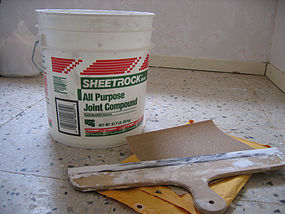- Joint compound
-
For pipe joint compound, see Pipe dope.
Joint compound (also known as drywall compound) is a white substance similar to plaster used to seal joints between sheets of drywall, primarily in building construction. It is often referred to simply as mud.
Contents
Ready-mix lightweight joint compound
Ready-mix lightweight joint compound is a pre-made form of joint compound designed for fast application and easy maintenance. The compound is a complex combination of water, limestone, expanded perlite, ethylene-vinyl acetate polymer and attapulgite. This delicate mixture of compounds gives it a very creamy texture which allows it to spread onto surface with great ease.
Usage
Ready-mixed joint compound is most commonly used in hanging drywall for new or remodeled homes. Application is simple and easy, usually never taking more than three or four coats. When used for new walls, joint compound effectively eliminates all blemishes from the surface of the drywall, such as drilled in screws, hanging tape, or drywall tape. Joint compound can be used to finish gypsum panel joints, corner bead, trim and fasteners, as well as skim coating. In addition, it is also very handy for fixing minor blemishes or damages to walls. It easily patches up holes, bumps, tears, and other minor damages.
Ready-mix joint compound is usually more forgiving than the traditional form of joint compound. It can be used for as long of a period of time as needed, and does not dry up unless left unattended for a long period of time. Traditional "mix-it-yourself" joint compound usually lasts for one to two hours before drying. However, if it happens to set for more than a few hours, then you will need to apply water very liberally as needed to retain its soft texture.
Often referred to as drywall taping mud, joint compound is the primary material used in the drywall industry by a tradesperson, or applicator, called a "taper" or "drywall taper." A similar compound is used in various ways as a sprayed-on textural finishing for gypsum panel walls and ceilings that have been pre-sealed and coated with joint compound. The flexibility and plastic qualities of joint compound make it a very versatile material both as sealer or finishing coat for wall surfaces, and also in decorative applications that range from machine sprayed texturing to hand-trowelled or even hand-crafted and sculptural finishes. In North America the application of joint mud and drywall tape sealer and trowelled joint compound on gypsum panels is a standard construction technique for painted wall and ceiling surfaces. Until more recently in North America, and through the world, several different plasters such as veneer plaster and "plaster of paris" have been used in a similar ways to joint compounds as fillers or for decorative purposes since ancient times, and the actual make up and working properties of these compounds is much similar. Modern ready-mixes or powder and water mixes are available in a wide range of styles from slow-drying to quick-drying to suit specific demands for use by contractors or decorators.
While joint compounds are used for bedding tape and initial layers overtop, it is best to apply topping compound for finish layer(s) that level and sand more evenly. Both require thinning for practical application. [1]
Health concerns
Joint compound mixes manufactured prior to the 1980s often contained a complex mixture of several substances. Among the additives used were asbestos fibers, which provided cohesiveness. Exposure to fibral asbestos has been linked to various health conditions, including cancer in some instances. Joint compounds manufactured from 1980 onward were required to have asbestos removed in favor of other compounds due to legislation to ban asbestos' widespread use.
See also
- Spackling paste
- Plastering
References
- ^ "Drywall Mudding". DrywallTips.org. http://www.drywalltips.org/mudding.htm. Retrieved 2010-12-03.
Categories:- Building
- Building materials
- Plastering
- Materials stubs
Wikimedia Foundation. 2010.


